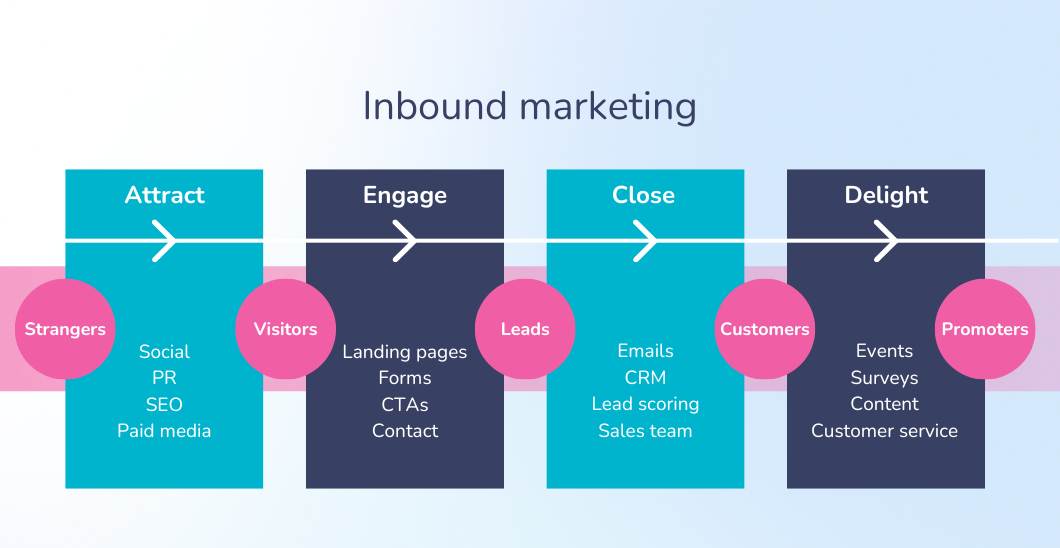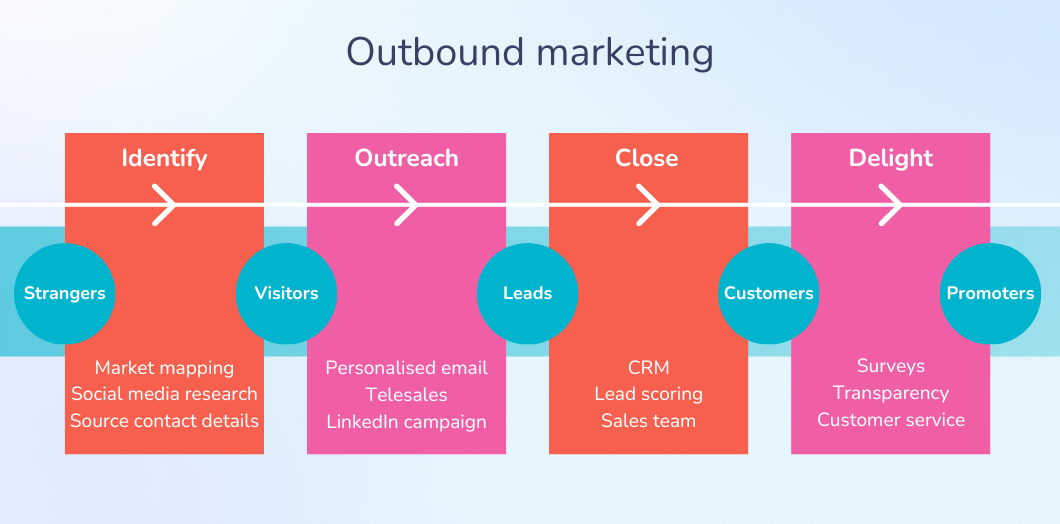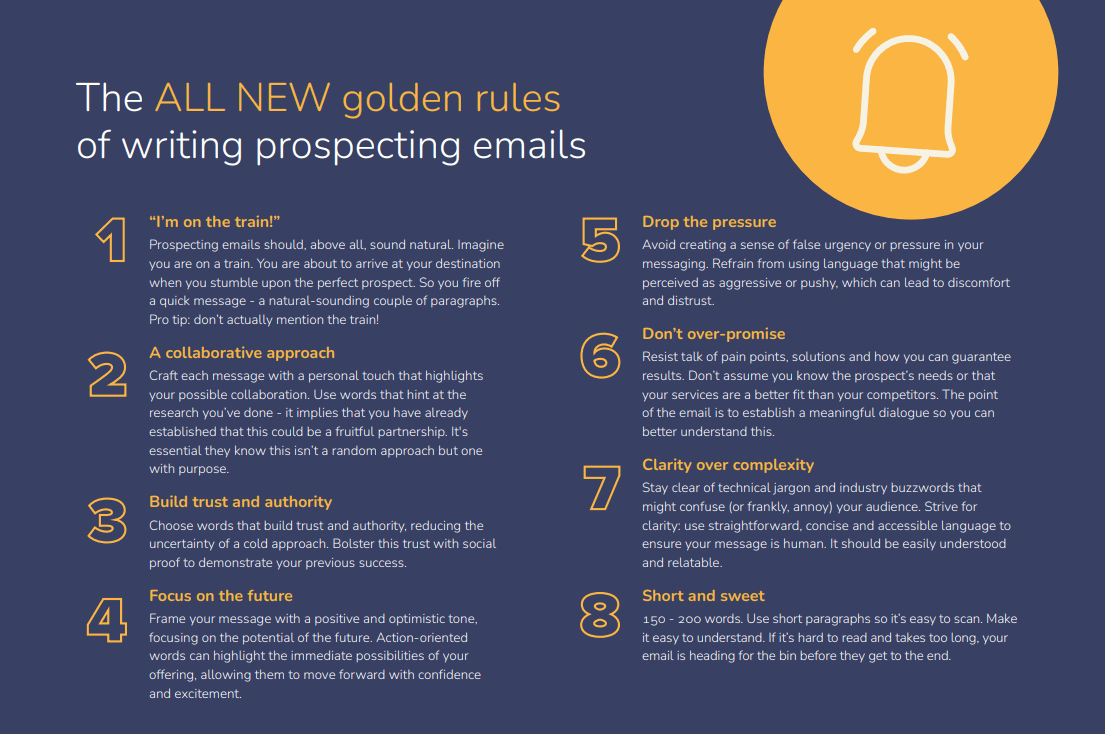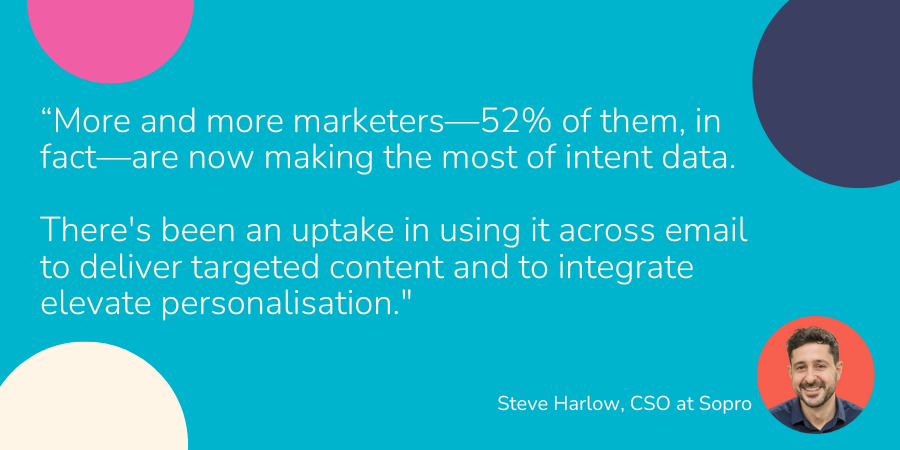Inbound vs outbound marketing: why B2B sales needs both

Inbound vs outbound is the fight we’ve all heard of. But what corner are you backing?
We’re here to tell you that sitting on the fence is sometimes good. If you want to reign supreme in the ring of B2B sales, you’ll want to employ both tactics. If your left hook and right hook are strong – what have you got to lose?
Follow us as we get into training mode—with fewer protein shakes than you’d expect. We’ll discuss the different aspects of inbound and outbound marketing and why two might be better than one,
Ding, ding. Round one.
What’s the difference between inbound and outbound marketing?
Here’s a simple definition that easily outlines the key differences:
Inbound marketing aims to produce content that positions a brand in front of relevant customers. The audience discovers the brand when they research a solution. Outbound marketing aims to discover and research relevant people, and initiate the conversation by sending messages out to that audience.
Another way of looking at the differences of inbound and outbound marketing:
- B2B outbound marketing aims to interrupt. The brand researches the audiences and presents them with a solution to pain points.
- B2B inbound marketing is discovered by the audience. The potential buyer researches a solution and finds the content.
Our hot take? You need to bring both together to have a well-rounded approach to your B2B lead generation strategy.
Let’s start with inbound marketing.
Inbound marketing
Inbound marketing aims to attract customers to a brand with engaging content or experiences. The content must offer something valuable and be educational, inspirational, or entertaining.
Inbound marketing starts with research into an audience and the different profiles within that target market. By understanding your audience, you can create content aimed at those specific audiences. This is vital because content marketing relies on knowing what the prospects are searching for.
In addition to content aimed at each persona, you need to create content that appeals to different stages in the B2B buyer journey. Potential customers will conduct different research at each stage.
Many won’t be ready to buy, but these leads can be nurtured until they are ready. By using content to consistently add value, a brand positions itself to be an authority in that particular area. In this way, the brand becomes part of the consideration set when a prospect enters the bottom of the funnel to make a purchase.

Inbound marketing channels
Let us assure you there are plenty of channels to choose from! From optimising your website, creating lead magnets (aka outstanding content), and making the most of social media, let’s take a closer look.
Content marketing
50% of marketers plan to increase their investment in content marketing this year, showing how vital this method is to their strategy.
That’s all the more reason to get creative. Compelling content can drive awareness, garner interest, and implement action.
When it comes to your content strategy, versatility always wins. Be sure that you have a range of available content, including:
- Blog posts
- Videos
- Podcasts
- Ebooks
- Templates and guides
- Case studies
- Whitepapers
Not only does this show off your industry prowess, but everybody consumes information in different ways, helping you cater to your audience’s different preferences.
One element to consider before creating a mass of content is the stage of the funnel you are trying to cater to. For example, at the awareness stage, you should create things like blogs, and at the discovery phase, you should focus your efforts on optimising your social media and website.
Harnessing content as part of your B2B inbound marketing strategy means acting as a valuable resource for your audience—providing them with the information they’re looking for but always leaving them wanting a little bit more.
If you want to get really savvy, you can gate content, creating an element of exclusivity. With this, you can then create a value exchange: their contact details for your outstanding content.
SEO
Search Engine Optimisation is integral to your inbound strategy. 68% of all online experiences start with a search engine, and the first result on Google’s SERP will receive 27.6% of all clicks for that search term. You need to be taking up the top spot.
There are plenty of strategies that can help with this:
- Website audits (what can you update)
- Checking in on that keyword research (what is your target audience searching for)
- Getting backlinks (getting other high-performing websites to link to you)
- Implementing a solid content strategy (this is where those blogs come in)
This tactic increases awareness of your offering through organic traffic. 70% of businesses have reported that SEO generates more sales on average than PPC—and it’s cheaper!
The higher you sit on a search engine results page, the more effective that awareness will be. It’s a long-term strategy, and you will see the benefits over a longer period of time.
Social media
Social media is one of the easiest ways to generate new leads and heighten brand awareness, engagement and website traffic.
After all, checking your social media pages might be a prospective buyer’s first port of call. So it’s important that they’re up to scratch. Audit your pages and ensure that there’s clear contact information available.
When thinking about what social media platforms to use, think about what you identified when ironing out your ideal audience.
For B2B, LinkedIn will be your obvious choice. But with 89% of B2B marketers already using this space, don’t be afraid to brand out into the land of Instagram, Facebook and YouTube.

Grow your LinkedIn network
The go-to guide for social selling if you’re in B2B sales
Read nowUtilise these platforms to create engaging content, and be sure to keep up with emerging trends.
Your content, whether organic or created for paid ads, must be sharable. Good content will also encourage conversation, generate user content and attract followers to your website.
Email newsletter marketing
Another popular form of inbound marketing, with 81% of B2B marketers going down this avenue. For good reason.
With this tactic, you can provide valuable, relevant content directly to the inboxes of your target audience.
You can easily position yourself as thought leaders and trusted advisors by sharing industry insights, expert advice, and company news. This consistent communication helps nurture relationships, build trust, and keep the brand top-of-mind.
Email newsletters also enable businesses to segment their audience and tailor content to specific needs, increasing engagement and conversion rates.
Remember to examine the data! By tracking metrics like open rates and click-through rates, you can gain quick insights into your audience’s interests and refine their strategies for better results.
Employee advocacy
Employee advocacy can be a valuable tool similar to that of UGC. And there’s a certain platform out there to help you create these authentic messages.
You guessed it… LinkedIn!
Companies can now create sponsored content from employee posts, offering a fresh way to amplify employee voices.
By doing so, companies can leverage their workforce’s genuine perspectives and experiences on their product or service to enhance their brand’s credibility and reach a wider audience.
This approach boosts engagement and helps build trust, as employees’ content is often perceived as more authentic and relatable.
Webchat
With AI’s rise and high adoption rates, you can now utilise the tech to automate customer interactions, handle enquiries, qualify leads, and provide personalised support. This is beneficial to enhancing engagement and freeing up your sales representatives’ time.
With 96% of consumers expecting a response within 5 minutes, use live web chat tools to start the conversation quickly.
The benefits of inbound
Inbound marketing offers numerous benefits for B2B businesses. If you need convincing, here are some of our top picks 👇:
- It focuses on attracting potential customers through valuable content and experiences tailored to their needs.
- Inbound tactics build trust and credibility as prospects engage with content that addresses their pain points and questions.
- It’s cost-effective compared to outbound tactics, as it relies on organic search, social media, and content marketing.
- Contributes to fostering long-term relationships by nurturing leads through the sales funnel with personalised communication.
Outbound marketing
Outbound marketing aims to deliver your message directly to customers. Researching your target audience is vital to ensure the content resonates.
The outbound approach is more direct than inbound, in two different ways.
First, instead of creating content that is available for everyone to consume, it focuses the message only on ideal customers.
A market map can be created which identifies relevant prospects who fit the ideal customer profile. This market map will reveal the size and composition of the audience. Further research verifies their contact details so the prospects can be messaged directly.
Second, outbound marketing is also more direct in its messaging. It aims to introduce somebody with a solution (or, to put it another way, a prospect with a sales agent).
Once that connection is made, the prospect enters the same sales funnel they would if they had come via inbound marketing.

Outbound marketing channels
So, without further ado, let’s examine some of the outbound tactics that will help you achieve your business goals.
Email marketing
If you work in sales, you might already be familiar with email, and it should come as no surprise that 67% of buyers prefer to be contacted via email.
Email outreach allows you to proactively reach potential clients directly in their inboxes and with the added touch of personalisation – which is key.
Emails can be tailored to target specific industries, roles, or pain points, increasing the relevance of the message. Go beyond first name and role, do your research, and you might just resonate.
Additionally, email marketing helps nurture leads by delivering valuable content, such as whitepapers or case studies, fostering trust and credibility over time.
We know a thing or two about sending the right message at the right time to the right person. Here are our golden rules:

Need a little inspiration for your first message? We’re an award-winning email marketing agency, so we know what works. Check out our guide on email prospecting; there are plenty of templates to help get you started.
Cold and warm calling
Cold calling is a sales technique in which salespeople initiate contact with potential customers who have not expressed prior interest in their products or services. Typically, it involves contacting unqualified leads via phone to introduce the offering and gauge interest. And if you’ve worked in sales, you’ve surely had a go.
In a nutshell, cold calling is:
- Making unsolicited outreach to potential customers using the phone.
- Doing so to introduce a product or service.
- Initiating this contact without prior expression of interest whilst relying on effective communication skills, persuasion, adaptability and an ability to generate interest to potentially make the sale.
So, let’s take a little look at warming this tactic up.
Warm calling is when salespeople contact prospects who’ve shown interest or engagement with your products or services. Unlike cold calling, this sales approach involves reaching out to leads who have demonstrated some level of receptivity. This makes the interaction targeted and, arguably, more successful. But we’ll get into that later.
To summarise, warm calling is:
- Phoning leads who have previously expressed interest or engagement with products or services.
- Leveraging pre-existing connections or interactions with prospects.
- A type of sales outreach which is more targeted, personalised and successful than cold calling.
Both can be valuable tactics for outbound marketing, but one is even more slightly personalised than the other. And from our experience we know this works well.
Direct mail
Don’t shrug it off! Digital marketing might be all the rage, but in a constantly switched-on world, it’s easy to understand why direct mail is having a revival.
In our State of Prospecting report, 18% of buyers said they were happy to be contacted by direct mail, up from 7% the previous year.
Direct mail is a unique approach but can be your secret weapon when layered into a multi-channel approach. It provides a tangible, personalised touch that grabs attention.
Delivering high-quality, relevant materials directly to recipients’ hands fosters trust and engagement, ultimately enhancing brand recall and driving conversions.
The aim of the game is to stay top-of-mind so that when your buyers are ready to purchase, they’ll come straight to you.
Paid ads
Using paid ads for B2B outbound outreach is a must. It’s an effective tool, enabling you to achieve precise targeting and broad reach across various digital platforms.
Paid ads on search engines, social media, and industry-specific websites allow businesses to target specific demographics, job titles, and interests, ensuring the message reaches relevant decision-makers. With an average of four decision-makers now involved in the buying process, it’s a great way to capture their attention.
Additionally, don’t sleep on those B2C spaces like Facebook or Instagram. Many business professionals use these platforms, allowing ads to reach them in a less saturated, more personal environment.
This approach can enhance brand visibility and recall, leveraging the extensive user bases of B2C channels to engage B2B audiences.
Thinking about leveraging paid ads but want accurate targeting and reduced spending? Well, you might just be in luck – check out what we’re doing with our Audience AdSync tool.
Intent tracking
Intent tracking is the process of monitoring and analysing online behaviours that indicate a potential interest in specific products or services. This includes actions like visiting particular web pages, downloading resources, or engaging with content related to a company’s offerings.

Intent tracking in B2B outbound marketing has many benefits. It enables sales teams to identify and prioritise leads who are actively showing interest, thereby increasing the efficiency of outreach efforts.
Understanding a prospect’s intent can tailor your messages to address specific needs and pain points, making communications more relevant and personalised. This targeted approach enhances the likelihood of conversion and shortens sales cycles. Additionally, intent tracking provides valuable insights into market trends and customer preferences, informing overall marketing strategies and improving campaign effectiveness.
The benefits of outbound
A different approach to your outreach, but one that can be equally as effective. Here’s a round-up of why we think outbound marketing is a strategy that you need to make the most of when it comes to your outreach:
- The power of direct reach. When you’ve clearly defined your audience, this tactic actively targets specific companies or decision-makers, ensuring the message reaches the intended audience.
- It generates immediate impact, generating quick responses and leads by directly engaging potential clients.
- Outbound marketing is great for brand awareness as it increases visibility and recognition in the market through consistent outreach efforts.
- Allows businesses to craft precise, tailored messages that highlight key value propositions and solutions.
- Actively drives new business opportunities by identifying and contacting potential prospects—a great addition to your lead generation strategy.
- Effective for market penetration: Allows you to enter new markets or segments by proactively introducing offerings to unfamiliar prospects.
- Outbound marketing is a scalable strategy. It can be scaled to reach a broader audience or focused on targeting specific high-value accounts.
Outbound and inbound email: a pitch for both
You might have seen email crop up twice in this guide…
Although inbound and outbound email marketing are different strategies, they work together to create a well-rounded marketing channel that covers all bases.
Some examples of how you can use inbound and outbound email marketing in tandem:
Building your email list
Outbound
Reach out to your entire audience (once you’ve built your email list) with an introduction and an invitation to talk more over the phone.
Inbound
Drive signups by placing forms strategically on your website and within your content.
Getting prospects to convert
Outbound
Encourage prospects to book a sales appointment to actively address concerns and convert them 1-2-1.
Inbound
Nurture your captive audience once they’ve signed up, and build a relationship over time.
Promotions and offers
Outbound
Identify and contact a group of prospective customers who you think might benefit from a current offer or promotion.
Inbound
Email a segment of your mailing list that has shown interest in a particular product and offer them a special promotion or discount.
Re-engaging
Outbound
Send emails to people who have gone quiet (but are still subscribed) and offer them special incentives to engage with your brand again.
Inbound
Send emails to people who have gone quiet (but are still subscribed) and provide valuable content to encourage re-engagement with your brand.
By using both inbound and outbound email marketing strategies in tandem, you can build a larger email list, promote your products/services to a wider audience, and keep your existing subscribers engaged and interested in your brand.
Why you need to make the most of outbound and inbound
A combination of inbound and outbound marketing is essential for a thorough and effective sales strategy. While we’ve discussed the differences between them, inbound and outbound marketing actually go hand in hand.
If you’re a small business, you’ll need to pick the channel that delivers a consistent flow of leads and strong ROI.
A mix of marketing channels is the best strategy for many brands, including medium and large companies. This way, you are not overly reliant on one channel, and you can tailor different messages between each- helping you to identify what works best.
It shouldn’t be a matter of pitching inbound vs outbound. Imagine the two working in perfect harmony… raising brand awareness through content marketing, nurturing leads with email and social, keeping front of mind with display ads, and then cutting through the noise to reach decision-makers with an introductory prospecting email. Sounds dreamy.
Want to refine your multi-channel strategies? Check out what our lead generation and appointment setting agency can do for you can your outbound lead generation.




Share